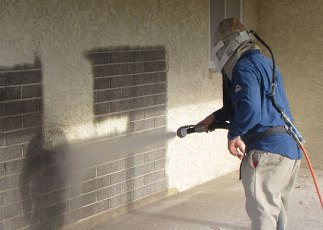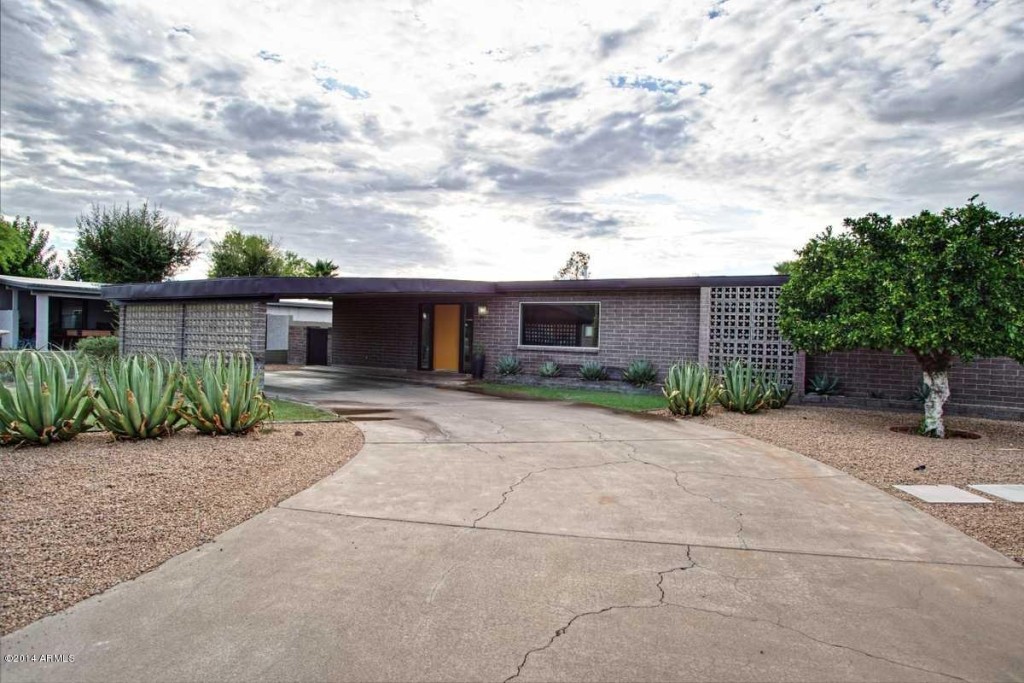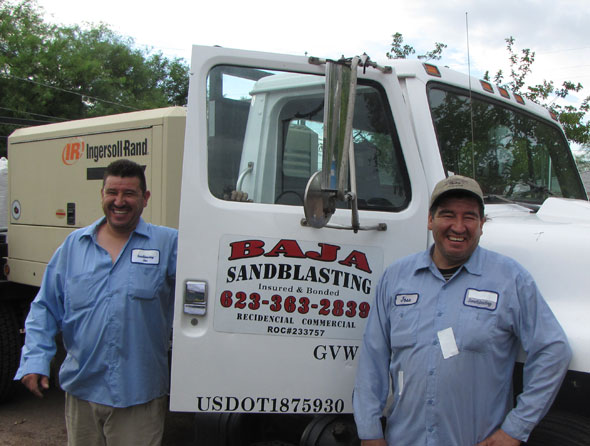
Sandblasting your Haver
Many of you have probably seen it in your own neighborhood, and have even considered doing it yourself. Sandblasting your Haver will give it a much more contemporary and updated look. In fact, Ralph Haver originally wanted to leave the block exposed. However, over the years styles have changed, and painting homes became trendy. Then in the 90’s came stucco, and boy do I hate stucco. All of Phoenix is a sea of tan stucco homes with tile roofs, and no personality. We’re different though. We don’t want the standard tract home, it’s why we live in a Haver Hood.
Prior to owning my Haver in the Haver Hood, Town and Country Paradise, I owned a simple mid-century ranch style home in Tempe. It was block construction, and it’s the first home I ever had sandblasted. It came out better than I could ever have imagined. At the time it cost slightly more than painting, but what’s great about sandblasting your home is you don’t really have to do anything to it ever again. Where as with painting the Arizona sun bleaches out the colors causing the need to paint every 6 to 8 years. I occasionally hose my house down to rinse off the dust, but that’s it!
Before Sandblasting my home
After Sandblasting my home
What follows is an exert of a step by step report that was put together by Bill Tonnesen a Landscape Architect who has done some pretty spectacular things around the valley. I encourage you to check out his site BillTonnesen.com. Of everything he has listed below I can’t recommend enough using a qualified company the does the masking, blasting, and clean up. The one downside to sandblasting is it’s very messy. It’s not only messy
for you, but the whole neighborhood. Make sure to talk to your neighbors ahead of time. Have them move their cars and even offer to sweep up any mess it causes on their property. Most people are reasonable and in my opinion you’re adding value to the neighborhood in the long run.
BLASTING THE BLOCK
Cinder Blocks, commonly called CMU or concrete masonry units, are the least expensive structural masonry units and are usually stuccoed and/or painted over. Have a test area blasted before you decide to go ahead. The number of coats of paint and whether it’s an ordinary latex or an elastomeric (meaning with a rubbery compound) paint will determine how difficult it is to remove. The longer and closer you blast the block the more cement and aggregate you’ll take off its surface. Most have black cinders that will be revealed if you go a little deeper than just removing the paint.
Be careful with the mortar between the block, especially the vertical joints (called head joints). They can blow out leaving openings called bee holes. These are entry points for water and insects. Patching them with fresh mortar is called tuck pointing. It must be done professionally to minimize staining and a blemished appearance. It’s important that you’re working with an experienced subcontractor. Do not rent equipment and try to do it yourself, its not worth it.
Any hardwood or fir will also look great sandblasted. Pine looks bad. Plywood, masonite, particle board and drywall don’t work at all.
PROTECT YOUR GLASS
Called frosting or etching, sandblasted glass is more often a masking mistake than an intentional effect.
MASK IT RIGHT
A high skill level is required. A common (and big) problem is masking that comes loose or doesn’t cover properly and next thing you know your window(s) are permanently frosted. Grey or red duct tape and masking tape are useless. When it’s super hot they will pull off when the air hits the plastic.
Start with clear 6 mil plastic sheeting. One sheet per window is enough but it must be double taped continuously all around. Use white 223 Polyken tape. It’s made by Berry Plastics.
A NOISY MESS
Sandblasting is super loud and messy. It is impossible to avoid everything in your house being covered in dust but good masking of all the doors and windows will help. Tell your neighbors you’re doing it and cover anything that’s within 20 or 30 feet. It’s very noisy.
Do not blast stucco or cmu dry. Do not sandblast if there is a chance there’s asbestos or lead in anything. Water should be mixed with the media at the tip. This is called “wet abrasive blasting” by the county. Years ago we would blast dry. What a mistake. It slows things down but water helps air quality and the chances of your neighbors calling in a nuisance OR disturbance to the City and getting shut down before you’re done. It’s also possible to use water with tenting; it’s not like a giant tent for termite fumigation; It’s a draping of 6 mil plastic around the blaster and his immediate work area. It’s not perfect but can help a lot.
Use a high pressure sprayer (not just the hose) after the blasting is done to remove sand and masonry grit that’s worked into the newly roughed face of the block. Anticipate a bunch of wheel barrows of grimy wet sand to clean up. The best situation is to not be living in the house when you blast it.
COST
If you go hourly (I don’t) they’ll all want over $100/hour. A price per square foot on cmu might be one to three dollars but it’s an awkward unit of measure. With loads of qualifications I’d say that if you had five companies come out and they gave you bids to do a 1400 square foot painted CMU house, you’d get prices from $1,500 to $4,000.
Often homeowners are planning to repaint and end up comparing that cost with sandblasting. Sometimes they’re close but painting is cheaper. The benefit of sandblasting is that aside from the occasional hose-down its virtually maintenance free for the lifetime of the building.
AVOIDING TROUBLE
Technically all sandblasting companies should have a Portable Source Permit from the county. Good luck. The things to be careful with are:
- Don’t let rain or hose water carry the mess into the gutter which is part of the city sewer system.
- The noise can shut you down. Most cities will have a “nuisance” zoning rule. Best bet is to approach all the neighbors ahead of time.
- Especially downwind, the dust will make a mess next door. You might advise and offer to sweep up and/or cover stuff. Again – approach the neighbors ahead of time.
- The county is the toughest. Check out Rule 312 on Abrasive Blasting
- Opacity is when a dust cloud obscures your view. The county says if visibility is 20% obscured for more than three minutes in any 60 minute period you can be cited. Best defense is blasting wet. I called several companies out of curiosity and they were generally negative on wet blasting. “Messy, slower, and doesn’t cut as well as dry,” were among the responses.
Note: I am neither qualified nor willing to offer advice on encapsulating or abating hazards such as lead or asbestos. Consult the county, then your attorney.








[…] to decorative block. Sawtooth the new block with the existing and paint to match, or better yet, sandblast and you’ll never know it wasn’t intended to be […]
We sandblasted our home and it was the best design decision we could have made! Great tips!